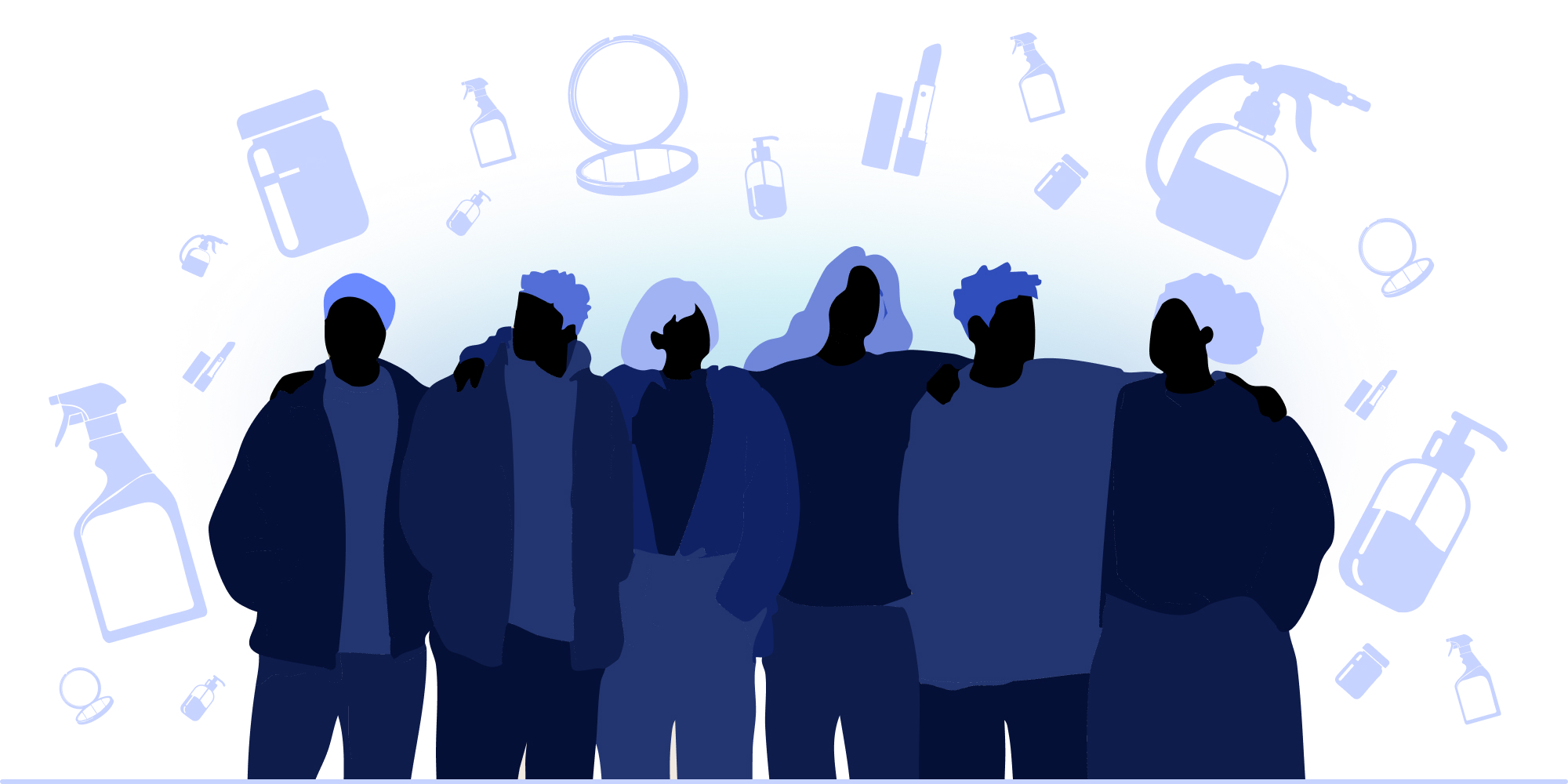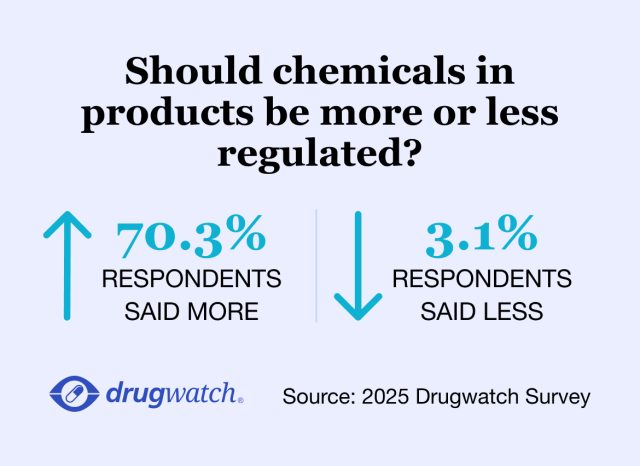After Years of Regulation, Toxic Chemicals in Everyday Products Still Endanger Americans
From cleaning sprays to shampoos, millions of everyday products contain chemicals that may cause dangerous health risks. Carcinogens that trigger cancer, endocrine disruptors that interfere with hormones and other chemicals linked to side effects are still found in items Americans use daily.

According to a Drugwatch survey, roughly 55% of people use between one and five chemical products in their home. Around 10% of people are very confident that these products are free of dangerous chemicals or substances.
However, regulatory loopholes, corporate cover-ups and delayed agency actions leave potentially harmful products on the shelves, exposing families to hidden dangers.
Drugwatch surveyed 1,000 people in the U.S. about their household chemical use, symptoms they might have suffered from these chemicals, and the responsibility they feel manufacturers should have for harming people or the environment.
People have filed lawsuits against some manufacturers after developing cancer, neurological problems and reproductive disorders they believe were caused by products that were marketed as safe. These cases have sparked recalls, bans and industry reform.
For many households, the most hazardous chemicals lurk just under the sink, in the shower, in the garden shed and even in tap water.
| Formaldehyde | Prevents the growth of microbes in water-based products | Baby shampoos, body soaps, color cosmetics, mascara, nail polishes | Allergic reactions, asthma, cancer, respiratory symptoms |
| Fragrances | Product distinction, scent enhancement/masking | Air fresheners, cleaning sprays, laundry detergents, perfumes, shampoos, shaving creams | Allergies, birth defects, cancer, hormone disruption, respiratory irritation |
| P-phenylenediamine (PPD) | Dye/colorant in hair products | Hair dyes | Allergic reactions, cancer, renal failure, respiratory distress |
| Perfluoroalkyl and polyfluoroalkyl substances (PFAS or “forever chemicals”) | Nonstick coating, water/heat resistance | Carpets, cleaning products, dental floss, eye makeup, nail polish, nonstick cookware, shampoo, water-resistant clothing | Developmental delays, high blood pressure, higher cholesterol levels, immune suppression, increased cancer risk, reproductive harm |
| Phthalates and parabens | Phthalates: Increase plastic’s durability Parabens: Preservatives | Cosmetics, food containers, lotions, pharmaceuticals, plastics, shampoos, toys | Allergies, endocrine disruption (fertility and hormone changes), increased cancer risk, reproductive harm, respiratory problems |
| Talcum powder | Absorbs moisture, opacifier, prevents caking, reduces friction | Baby powder, blush, chewing gum, eyeshadow, liquid makeup, medications, pressed powders | Blisters, coma, difficulty breathing, lethargy, low blood pressure, cancer (including ovarian) |
Phthalates and parabens found in makeup, shampoo and skin care products are just two of several concerning chemicals, according to Dr. Michael T. Kleinman, professor of environmental and occupational health at UC Irvine Joe C. Wen School of Population and Public Health.
“These are known hormone disruptors and are toxic to the reproductive system. Some have been linked to immune system dysfunction and some are carcinogens,” Kleinman told Drugwatch.

Regulatory Gaps and Loopholes
Agencies like the U.S. Environmental Protection Agency (EPA), the U.S. Consumer Product Safety Commission (CPSC) and the U.S. Food and Drug Administration (FDA) monitor health risks posed by toxic products, but gaps in these systems could be putting your health at risk.
The regulatory system in the U.S. is largely reactive and not proactive, Dr. Michael S. Bloom told Drugwatch. Bloom is a professor of global and community health at George Mason University College of Public Health.
“Chemicals are typically presumed safe until evidence demonstrates harm, following a model that treats them as ‘innocent until proven guilty,’” said Bloom. “A similar approach applies to chemicals regulated by the Food and Drug Administration (FDA) in cosmetics and personal care products, where pre-market safety testing is not required for most ingredients.”
In addition to regulatory shortcomings, many corporations have used loopholes to conceal the risks of toxic chemicals in consumer products. This has allowed the widespread use of chemicals linked to cancer, reproductive disorders and more, often delaying consumer protection and manufacturer accountability.

Around 70% of people surveyed by Drugwatch think there should be more regulation on chemicals in consumer products, not less.
Regulators Are Behind on Testing and Slow To Act
More than 86,000 chemicals are on the EPA’s Toxic Substances Control Act list. Many haven’t been tested for safety or toxicity, and only 1.8% have information published about how they impact human health.
While regulatory agencies have been more proactive in recent years with gathering data on chemicals and risks, they may not always act on their findings.
For example, the CPSC has the power to ban or regulate hazardous chemicals in consumer products. However, it rarely does.
In 2023, the CPSC released a report identifying 16,229 PFAS, commonly known as “forever chemicals.” This includes 863 used in consumer products. Despite concerns that these substances could pose several health risks, such as cancer, only 83 PFAS had data for human health risks. Thirty types of PFAS had restrictions in the U.S. or internationally.
The agency hasn’t taken any specific actions in response to these findings.
In 2025, the EPA announced it would extend the time for public water systems to meet the contaminant level restrictions for the most common PFAS (PFOA and PFOS) from 2029 to 2031. The agency didn’t specify how it would hold polluters accountable.
Manufacturers Use Loopholes to Bypass Scrutiny
Weak regulations allow manufacturers to exploit loopholes and bypass proper approval processes that ensure chemicals in consumer products and foods are safe.
For example, the FDA regulates food additives and chemicals. But the “generally recognized as safe” (GRAS) loophole allows food and chemical companies to bypass FDA approval. Under GRAS, companies are allowed to self-declare that a chemical is safe without applying for FDA approval.
The FDA used to have more authority to decide which chemicals were GRAS. However, it gave up its power to the industry in 1997, allowing companies to self-certify new food chemicals as safe.
Companies can even hide chemicals under the word “fragrance” on a product label thanks to the trade secret protections of the Federal Fair Packaging and Labeling Act (FPLA). The FPLA prevents the FDA from making manufacturers disclose the chemicals in fragrances.
Under U.S. law, manufacturers of chemical products don’t have to list their ingredients or make them public.
Consumer Confusion: “Greenwashing” and Misleading Labels
Greenwashing is a potentially deceptive marketing practice where companies make environmental claims about their products, packaging or business to appear more eco-friendly.
Manufacturers use terms like “environmentally friendly,” “green” and “non-toxic” to market their products. Unfortunately, these terms may mislead consumers about actual safety or environmental impact.
These claims are popular with cleaning products because they appeal to people trying to buy safer household cleaners. For example, Clorox’s Green Works products used “non-toxic and biodegradable” on their label to appeal to consumers. However, these products contained chemicals like 2-butoxyethanol, which could depress the central nervous system and lead to other health issues.

Safety Concerns and Litigation
Toxic chemicals in various products have been featured in litigation against large corporations, including 3M, Bayer/Monsanto, DuPont, Johnson & Johnson (J&J), L’Oreal and others. Products named in these lawsuits include hair dye, hair relaxers, PFAS-containing products, talcum powder and weedkillers.
Litigation is often a byproduct of not requiring pre-market testing for chemical ingredients. If a product causes harm, legal action may follow and courts determine liability and compensation, Bloom said. In contrast, the European Union adopts a “guilty until proven innocent” approach, he explained. As part of the European Union’s Registration, Evaluation, Authorisation and Restriction of Chemicals (REACH) regulation, chemical safety must be proven before substances can be used in consumer products.
The main claims in many consumer product lawsuits in the United States are that companies manufactured products with toxic ingredients that caused serious harm and failed to warn the public. A few of these cases have resulted in billions of dollars in settlements.
Personal Care and Cosmetics
Some of the largest active litigations stem from cosmetic products like hair dye, hair relaxers and talcum powder. Plaintiffs claim these products contain toxic substances that led them to develop various cancers.
- Hair dye lawsuits:
- Hair dye lawsuits against Clairol, L’Oreal, Wella and more allege that chemicals in hair dyes caused plaintiffs to develop cancers, including bladder, non-Hodgkin lymphoma, thyroid and triple-negative breast cancer.
- Hair relaxer lawsuits:
- Women have sued various chemical hair relaxer and straightener manufacturers. They allege that chemicals in the products, including phthalates like di-2-ethylhexylphthalate and other endocrine-disrupting chemicals, caused or increased their risk of breast, ovarian or uterine cancer. Other injuries include endometriosis and uterine fibroids. There are almost 11,000 active lawsuits in the Northern District of Illinois. Defendants include L’Oreal and Shoftsheen-Carson.
- Talcum powder lawsuits:
- Around 67,000 talcum powder lawsuits are consolidated in New Jersey that claim J&J’s talcum powder products were contaminated with asbestos and caused women to develop ovarian cancer. Unlike chemicals in other cosmetics, asbestos is a natural mineral, but it can cause mesothelioma and larynx, lung and ovarian cancer.
The FDA’s regulatory power over cosmetics has been less robust than other products. Despite some changes brought about by the Modernization of Cosmetics Regulation Act of 2022 (MoCRA), problems still exist.
For example, the FDA does not approve cosmetic products or ingredients before they go on the market. Although it requires manufacturers to verify safety and report serious adverse events, it doesn’t clearly state what is considered adequate cosmetic safety substantiation.
PFAS (“Forever Chemicals”)
Litigation stemming from PFAS includes water contamination, firefighting foam (AFFF) and firefighting gear lawsuits. These lawsuits claim that PFAS contamination caused plaintiffs to develop various cancers, including kidney and testicular cancer, as well as health problems like liver damage and pregnancy complications.
According to Drugwatch’s survey, 62.3% of people are concerned about the health risks of chemicals like PFAS, but 23.9% don’t know enough about these risks. This highlights the need for more education and awareness about these dangerous chemicals.
PFAS lawsuits claim that chemical makers 3M and DuPont knew about the dangers of PFAS as far back as the 1970s but dumped the toxic chemicals into water supplies and didn’t warn the public.
In 2023, 3M announced PFAS settlements in the amount of $12.5 billion. DuPont added $1.2 billion to the settlement. The litigation is ongoing.
Roundup and Glyphosate
Roundup lawsuits against Bayer (formerly Monsanto) claim that the active ingredient, glyphosate, can cause non-Hodgkin lymphoma. Litigation also alleges that the manufacturer didn’t warn regulators or the public.
Over 17,000 Roundup lawsuits have been brought against Bayer. So far, Roundup settlements and verdicts total more than $11 billion.
Beyond Side Effects: Kathy’s Roundup Cancer Story
Paul Spreadbury filed a wrongful death lawsuit on behalf of his wife Kathy, who died from B-cell non-Hodgkin lymphoma after using Roundup for years.
Before Kathy got sick, he expected that Roundup had been tested for safety.
“I expect they did [test it], but at the time I had no idea of what the testing procedure was and what, if any, other factors came into play beyond the safety of the product,” Spreadbury said.
His experience with Roundup and the tragic loss of his wife make him question the way chemicals are regulated in the U.S.
“Their primary mission is not to regulate and protect the customer, it’s to regulate and protect the profits of the company, their jobs and ambitions,” he said.

The Effect of Lawsuits on Regulations and Safety
Lawsuits have led to some dangerous products being removed from the market. Confidential documents released during litigation have helped spread awareness about potentially harmful ingredients and exposed corporate cover-ups.
Almost 95% of people surveyed by Drugwatch thought that companies whose products were found to cause health problems or environmental damage should face financial penalties.
One example of a large financial penalty for chemical pollution is the $450 million settlement 3M agreed to pay to New Jersey over natural resource contamination in May 2025.
While landmark litigation has generated multibillion-dollar settlements, its effect on regulatory reform has been inconsistent.
Dangerous Chemicals Exposed
Documents obtained during discovery in two landmark lawsuits, 1998’s Tennant vs. DuPont and 2002’s Leach vs. DuPont, exposed the dangers of PFAS to the public. These documents also revealed 3M and DuPont’s role in polluting water supplies.
In Tennant vs. DuPont, the plaintiff alleged that DuPont dumped over 7,100 tons of PFOA-laced sludge onto his property. In Leach vs. DuPont, more than 80,000 West Virginia plaintiffs charged DuPont with contaminating the local water supply with PFOA and PFOS.
Lawsuits also expose company cover-ups. Internal memos and documents obtained from Monsanto in Roundup lawsuits showed that the company knew that glyphosate was probably toxic to human health, but didn’t reveal this risk to the public.
Consumer Awareness
Knowledge of product lawsuits makes consumers more aware of potential safety issues associated with the items they bring into their homes. These safety signals influence what products they choose to buy.
About 43% also said they weren’t aware of product recalls or settlements involving household chemical products.
After J&J faced ovarian cancer and mesothelioma litigation, the health care giant stopped selling talcum powder products in the U.S. in 2020. In 2023, the company discontinued talc-based Johnson’s Baby Powder globally.
Similarly, following a barrage of Roundup lawsuits, Bayer announced its decision to remove glyphosate from its residential formulas by January 2023.
Legislative Changes
Legislative changes concerning potentially toxic products have been mixed, with some laws being more consumer-friendly than others.
In 2024, the FDA and EPA took significant action when it came to PFAS. The FDA announced a voluntary ban on PFAS in food packaging, including microwave popcorn bags, take-out containers and fast-food wrappers. The EPA set its first regulatory limits on PFAS in drinking water.
States have also enacted their own protections for certain chemical categories.
“In the absence of comprehensive federal action on certain product categories, regulators in several states and municipalities have stepped in. For example, California, New York and Vermont have enacted laws that ban or require disclosure of potentially harmful chemicals, such as PFAS, phthalates and formaldehyde in menstrual products,” Bloom said.
While some laws can benefit consumers, others may help protect manufacturers. Legislative changes for Roundup are a good example of mixed regulatory results. For example, California added glyphosate to its Proposition 65 registry of chemicals known to cause cancer in 2017, potentially providing more protection for consumers.
However, Bayer has also pushed for laws that will shield it and other pesticide companies from claims that they failed to warn consumers that their product causes cancer. A law in North Dakota took effect on August 1, 2025 that protects manufacturers if the product label complies with the EPA’s regulations.
Bayer plans to pursue the law in several other states. Critics say the law could deny consumers the right to sue companies that sell harmful products.
Some bills designed to improve consumer safety may not make it past the introduction stage without support.
The Safer Beauty Bill Package was introduced in July 2025. Made up of four separate bills, they’re intended to build upon the Modernization of Cosmetics Regulation Act (MoCRA). These bills include bans of chemicals, stronger ingredient disclosures on labels and more funding for research and education on toxic chemicals.
So far, the four bills have been referred to the House Committee on Energy and Commerce, but haven’t seen any other movement since they were introduced. You may be able to help these bills get passed by contacting your representatives and voicing your support.
How Can Regulators Improve?
The first step to improving the safety of chemical-containing consumer products is to spread awareness and make ingredient information more transparent.
When asked about how to reduce oversight and improve consumer safety, Kleinman suggests we “strengthen labeling laws to allow consumers to see the information that can help them make informed decisions about purchases. Improve the screening of new additives and prevent potentially harmful products from entering the marketplace.”
While stronger labels are a good start, they’re not enough, according to Bloom.
“Empowering federal regulators with the authority to limit or prohibit hazardous chemicals in personal care items and other consumer goods remains essential … The combination of potential harm and widespread exposure, especially among sensitive populations like pregnant people and young children, warrants a precautionary approach,” Bloom said.
He advocates for a program that would require stricter safety demonstrations for new chemicals, much like the REACH program already practiced in the European Union.

What Can You Do To Stay Safe?
You can significantly reduce your risk from chemicals in household products by combining label awareness, proper use and storage, substitution, and vigilance about recalls and regulatory changes.
“Online resources such as SkinSafe.com, the Environmental Working Group’s Skin Deep and the Consumer Product Information Database provide detailed ingredient information for thousands of commercially available products,” said Bloom.
- Limit Exposure in Food and Personal Care
- Use cast-iron or stainless-steel cookware instead of nonstick pans, and avoid microwaving food in plastic containers to decrease your exposure to PFAS and BPA. Wash fruits and vegetables before eating, and consider buying some organic foods to limit your pesticide exposure.
- Practice Safe Use and Storage
- Follow all directions and never mix chemicals (e.g., bleach + ammonia) as this can produce hazardous gases. Wear gloves, eye protection and ensure proper ventilation when you handle toxic chemicals. Store chemicals in their original containers where children can't reach them.
- Read Labels and Research Products
- Look for chemical contents and safety instructions. Avoid products with unfamiliar ingredients or warnings about toxicity. Do not rely solely on terms like "green" or "natural" since these are often unregulated.
- Stay Informed on Recalls and Safety Alerts
- Check the CPSC, EPA and FDA websites regularly for updates on product recalls and consumer safety advisories. Pay attention to news of investigations, product lawsuits or new regulations about hazardous household products.
- Use Safer Alternatives
- Clean with baking soda, soap, vinegar or water instead of harsh chemical cleaners. When purchasing household goods, choose items labeled "flame-retardant free," BPA-free and PFAS-free. Avoid fragrances when possible.
When in doubt about chemicals in products, you can look for the Safer Choice label from the EPA and research safer products on the EPA’s website. You can also learn more about toxic chemical lawsuits on Drugwatch.
Calling this number connects you with a Drugwatch.com representative. We will direct you to one of our trusted legal partners for a free case review.
Drugwatch.com's trusted legal partners support the organization's mission to keep people safe from dangerous drugs and medical devices. For more information, visit our partners page.


